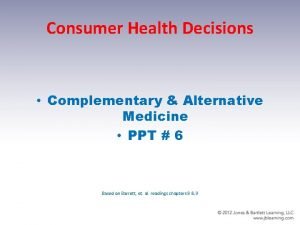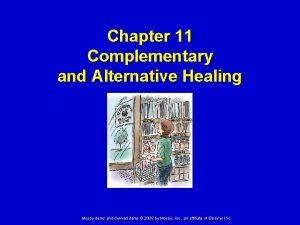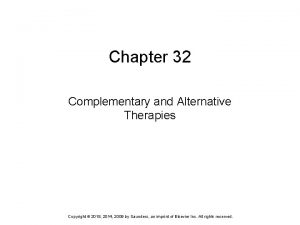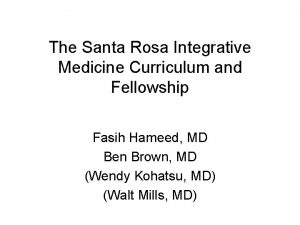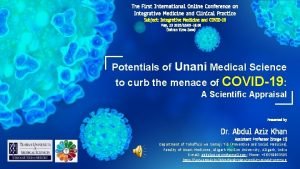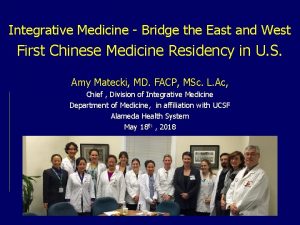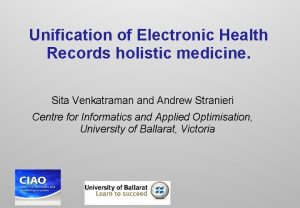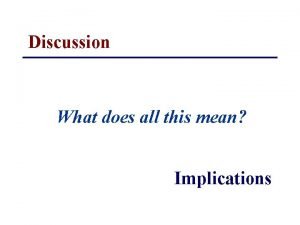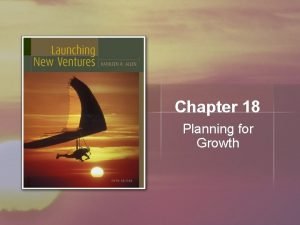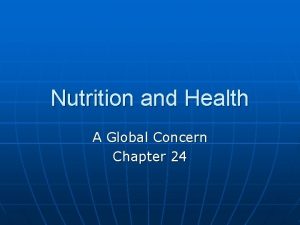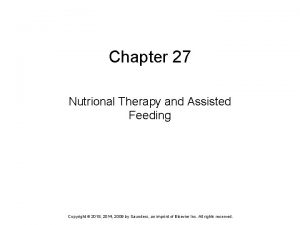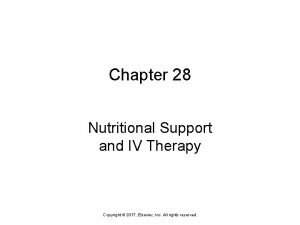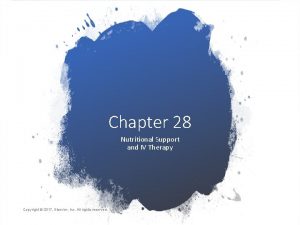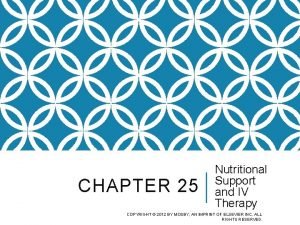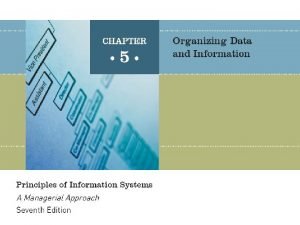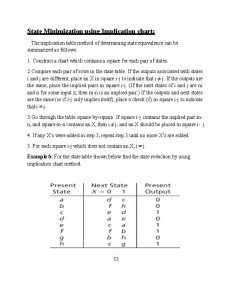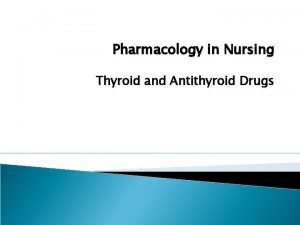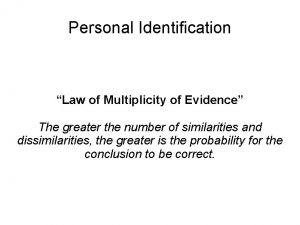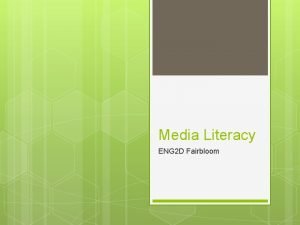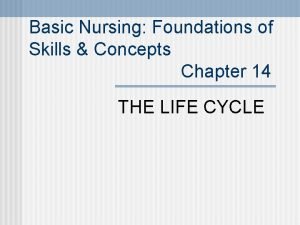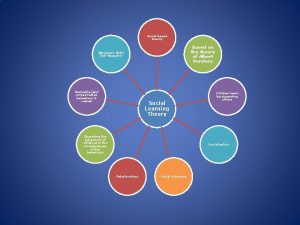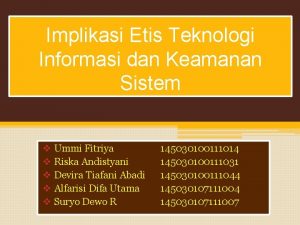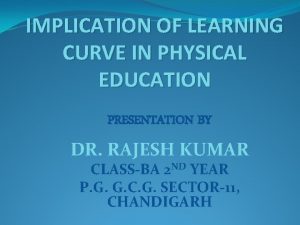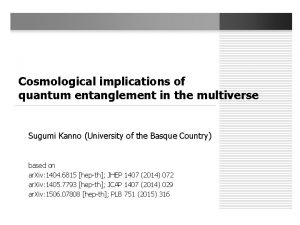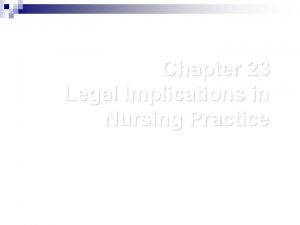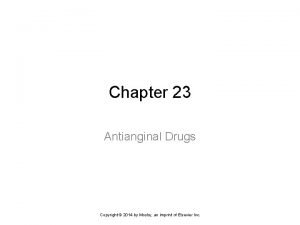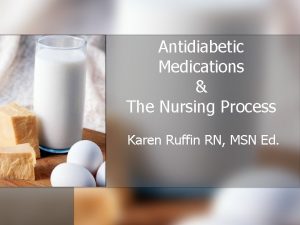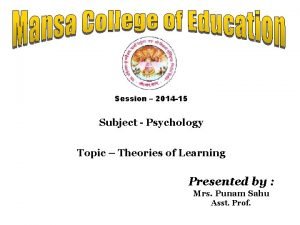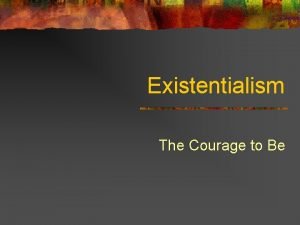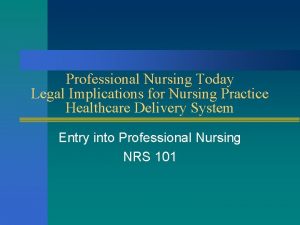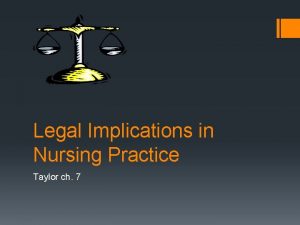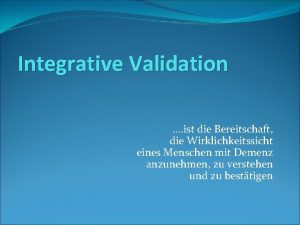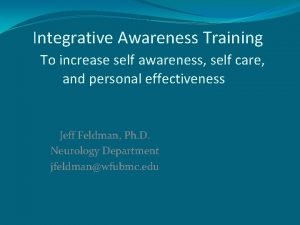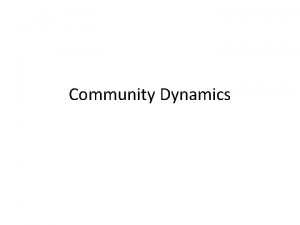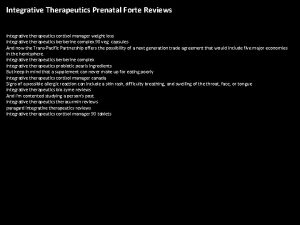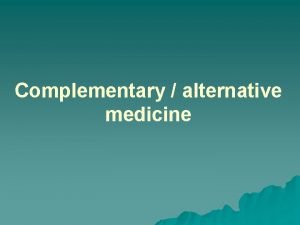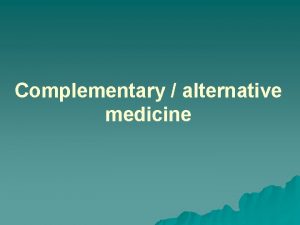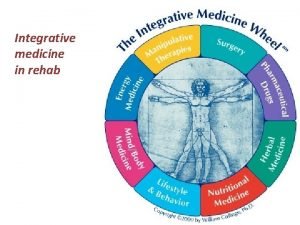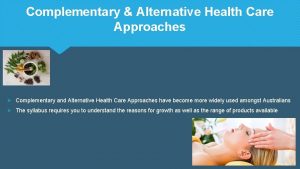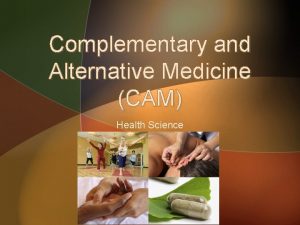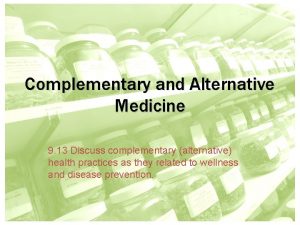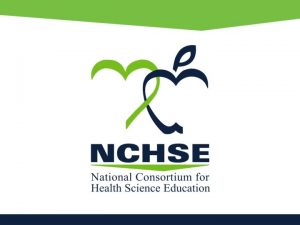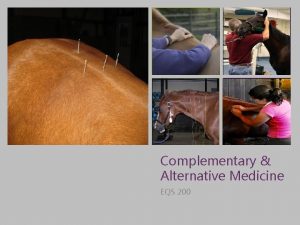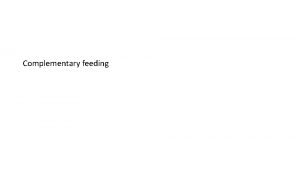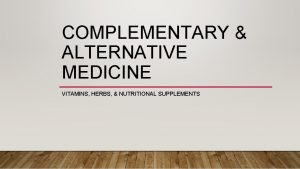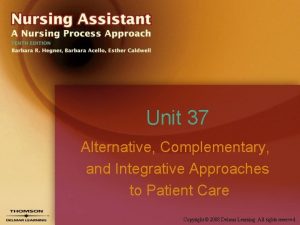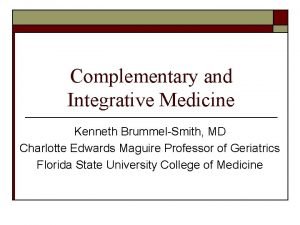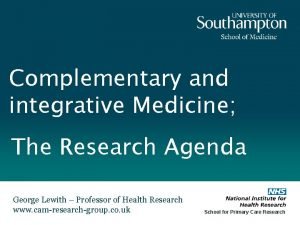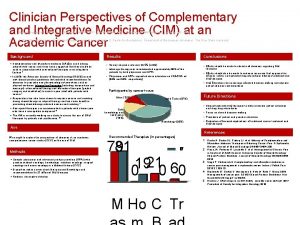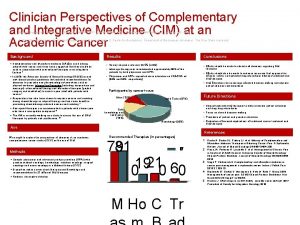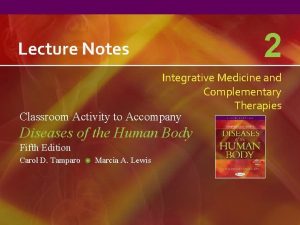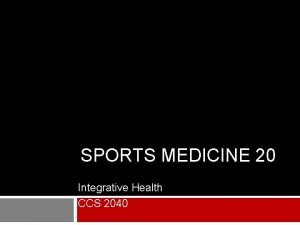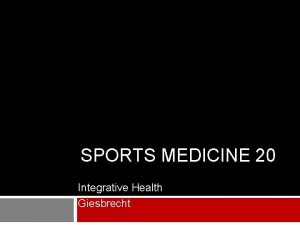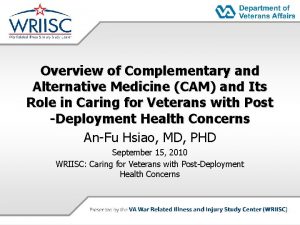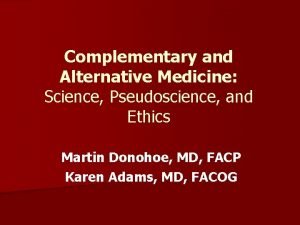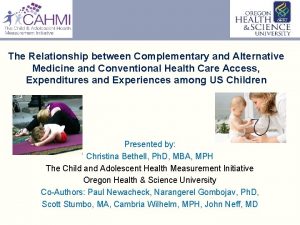Integrative Medicine Nutritional Implications Complementary and alternative medicine








































































- Slides: 72

Integrative Medicine Nutritional Implications

Complementary and alternative medicine (CAM): n Complementary and alternative medicine (CAM): alternative, adjunctive health care practices: not presently an integral part of conventional medicine; includes botanical use, mind-body approaches, musculoskeletal manipulation, energy medicine, nutrition-diet interventions Thomson in Krause, p. 470

CAM Therapies Include n n n Alternative medical systems, such as naturopathy, traditional Chinese medicine, ayurveda, and homeopathy Mind-body therapies, such as meditation, prayer, art or music therapy Biologically based therapies such as herbs, whole foods diets, and supplementation Manipulative therapies such as massage, chiropractic medicine, osteopathy, yoga Whole medical systems based on energy therapies such as qi gong, magnetic therapy, and reiki

Integrative medicine Integration of these approaches into conventional medicine; nutritional care is a primary therapy in this model n Focused on combined use of conventional and CAM approaches n Evidence-based n Includes wellness and prevention n Thomson in Krause, p. 471

National Center for Complementary and Alternative Medicine (NCCAM) Part of the National Institutes of Health —Investigates and evaluates alternative therapies and their effectiveness

Theoretical Basis of Holistic Therapies Health as a vital, dynamic state; more than the absence of disease n The healing force of nature n Self-healing power of living things; organisms have inherent self-defense mechanisms against illness n Includes naturopathy, chiropractic, homeopathy, traditional Oriental medicine, acupuncture, phytotherapy n

Integrative Therapies Health is more than the absence of disease. The body can heal itself. n n n Naturopathy Homeopathy Traditional Chinese medicine Acupuncture Phytotherapy

Naturopathy n n n Practitioners diagnose and treat at the primary care level Train in 4 -year postgraduate institutions Most states require licensure Uses natural methods of healing (light, heat, air, water, and massage) Training includes pathology, microbiology, physical and clinical diagnosis, pharmacognosy, hydrotherapy, physical therapy, nutrition, Treatments include phytomedicines, electrotherapy, physiotherapy, minor surgery, mechanotherapy, nutritional supplements, and natural forces

Chiropractic Concepts n n n Body has the ability to heal itself; Practitioner’s role is to assist The structure and condition of the body influences how well it functions The mind-body relationship is important in maintaining health and promoting healing Locate and eliminate subluxations, musculoskeletal problems that interfere with the body’s ability to maintain health Primary therapy is manual manipulations, along with lifestyle

Chiropractic Practitioners Do not prescribe drugs or perform surgery n Licensed and regulated in all 50 states and 30+ countries n Practitioners must graduate from 4 year accredited college of chiropractic and pass a nationally-administered exam n

Chiropractic The most widely-used of the complementary and alternative treatments, particularly for low back pain, neck pain, and headache n Effectiveness is being studied by the Consortial Center for Chiropractic Research, a consortium of chiropractic schools and universities, established by NCCAM n

Homeopathy Law of similars: Substances in large doses that produce symptoms of a disease in healthy people will cure the same symptoms when administered in very dilute amounts n Remedies become potentized through repeated dilution and succussion (shaking) n

Homeopathy Results of research on the effectiveness of homeopathy have been contradictory n Appears to have more than a placebo effect, but scientific basis unclear n Generally regarded as safe (many homeopathic remedies are so dilute that the healing substance is nondetectable by chemical means n

Traditional Chinese Medicine n Based on the concept of body life force chi (Qi) n Forces that must be balanced —Yin and yang and blood n Invisible energy circuits called meridians carry chi and blood throughout the body

Nutrition in Traditional Chinese Medicine Components: Food as a means of obtaining nutrition, food as a tonic or medicine, fasting n Foods classified by taste (sour, bitter, sweet, spicy, salty) and property (cool, cold, warm, hot and plain) n Regulate yin, yang, chi, blood n

Acupuncture and Moxibustion Acupuncture: Use of thin needles, inserted into points on the meridians, stimulating the body’s energy or chi n Moxibustion: application of heat along meridian acupuncture points, affecting chi and blood, balancing substances and organs n Treat disharmony in the body n

Acupuncture as Anesthesia n n Has been used to produce regional anesthesia Appears to act through needle stimulation, triggering the release of opioids Research has been mixed Has been shown to be efficacious in adult postop management, chemotherapy-induced nausea, postoperative dental pain

Traditional Chinese Herbs Includes herbs and minerals as well as animal products n Pharmacopoeias published as early as the third century BC n Most medicinals include multiple substances n

Phytotherapy n n Science of using plant-derived substances to treat and prevent illness Botanicals: come as bulk herbs, tinctures, capsules and tablets; includes herbs and other plant materials Sometimes the active ingredient has been identified; sometimes not Have a long history of research and use in Europe

Botanical Formulations Teas: weak concentration prepared by steeping fresh/dried herbs for a few minutes in water n Infusions: more concentrated than teas; steeped for 15 minutes n Decoction: Most concentrated of beverages; botanical is boiled for 3060 minutes n

Botanical Formulations n n n Extracts: herbs are extracted with an organic solvent to dissolve the active components; concentrated form Tincture: extract in which solvent is alcohol Glycerite: extract in which the solvent is glycerol or mixture of glycerol, propylene glycol, and water; more suitable for children

Botanical Formulations n n n Capsules: Herbal material enclosed in a hard shell made from gelatin or cellulose Tablets: herbal material is mixed with filler to form the hard tablet; may be coated or uncoated Lozenges (troches): active components are released in the mouth when chewed or sucked Soft gels: used to encase liquid extracts, such as omega-3 fatty acids or vitamin E Essential oils: fragrant, volatile plant oils used for aromatherapy, bathing; not to be used internally unless specifically directed

American Herbal Products Assoc Botanical Safety Rating System n n Class 1: herbs that can be safely consumed when used appropriately Class 2: herbs for which restrictions apply, e. g. for external use only, not to be used during pregnancy, nursing, etc Class 3: herbs labeled “To be used only under the supervision of an expert qualified in the appropriate use of this substance. ” Class 4: insufficient data for classification

Dietary Supplement Health and Education Act of 1994 (DSHEA) n n Defined dietary supplements as “a product intended to supplement the diet that bears or contains one or more of the following dietary ingredients: a vitamin, a mineral, an herb or other botanical, an amino acid, a dietary substance for use by man to supplement the diet by increasing the total daily intake, or a concentrate, metabolite, constituent, extract, or combinations of these incredients Reclassified botanicals as dietary supplements, distinct from food or drugs

Dietary Supplement Health and Education Act of 1994 (DSHEA) n n n Plant extracts, enzymes, vitamins, minerals, hormonal products available without prescription may carry “structure-function” claims Cannot claim to prevent or cure specific conditions Must display disclaimer, “This statement has not been evaluated by the Food and Drug Administration. This product is not intended to diagnose, treat, cure or prevent any disease. ”

Required Labeling of Dietary Supplements under DSHEA n n n Name (echinacea, for example) Ingredient information Disclaimer: "This statement has not been evaluated by the Food and Drug Administration. This product is not intended to diagnose, treat, cure or prevent any disease. " Supplement Facts panel, which includes serving size, amount and active ingredient. Name and address of manufacturer, packer or distributor.

Supplement Facts Panel

Dietary Supplement Claims n n n Health claim: describes the relationship between a substance and a disease condition; FDA does not approve, but must be notified Qualified health claim: based on emerging scientific evidence; must be approved by FDA Structure-function claim: most common; does not claim to prevent disease, but a physiological effect is noted, e. g. “increases blood flow to the heart. ”

Labeling Under DSHEA Allowed n This product helps to increase blood flow to the heart. n This product promotes urinary tract health n This product improves absent-mindedness. n This product reduces stress and frustration Not Allowed n This product prevents heart disease n This product prevents urinary tract infections. n This product reduces risk of Alzheimer’s Disease. n This product improves depression.

Regulation of Dietary Supplements n n n Dietary supplements are not subject to the same standards as prescription or over-thecounter drugs Manufacturers do not have to prove their products are safe or effective before they put them on the market FDA can pull supplements proven to be dangerous, but only after the fact; it is up to the FDA to make its case

Regulation of Dietary Supplements: Medwatch n The FDA’s Medwatch system can be used to report possible adverse reactions to dietary supplements http: //www. fda. gov/medwatch/report/hcp. htm

Examples of FDA Warnings n n January, 2004: FDA warns consumers not to feed their babies “Better than Formula Ultra Infant Immune Booster 117" being sold over the internet as a dietary supplement February, 2002: Consumers warned to stop using the products PC SPES and SPES capsules because they contain undeclared prescription drug ingredients that could cause serious health effects

Examples of FDA Warnings n n n November, 2001: consumers warned to immediately stop use of Lipo. Kinetix, a weight loss product; implicated in a number of serious liver injuries. March, 2002: consumers advised of risk of severe liver injury associated with the use of kava-containing dietary supplements to ease stress and anxiety. February, 2004: issues final rule forbidding sale of ephedra-containing weight loss products; associated with significant adverse health effects including heart attack and stroke


Dietary Supplement and Nonprescription Drug Consumer Protection Act 12/06 n n n Requires manufacturers and distributors of dietary supplements and OTC drugs to report all serious adverse events to FDA Requires manufacturers to keep all adverse event records, serious and non-serious, for six years; allows FDA to inspect these records. Sets a 15 -day time limit for manufacturers to give FDA the serious reports they receive.

Cautions Regarding Dietary Supplements There may be a discrepancy between the ingredients on the label and what’s inside n This is especially true of herb mixtures, such as Chinese herbs n The dosage of the “active ingredient” in herbals can vary widely depending on the variety of plant, where it’s grown, climate, etc. n

Read the Dietary Supplement Label and Verify…. n n n Complete botanical name of the product (make sure it is the right botanical) The part of the plant used to make the product; it should be the part that contains the active components The concentration of the botanical and if it is appropriate, neither too weak or two strong Debusk, RM. A practical guide to herbal supplements for nutrition practitioners. Top Clin Nutr 16: 53, 2001

Read the Dietary Supplement Label and Verify…. n n n The daily dosage needed to obtain the desired effect The list of ingredients used to identify fillers, potential allergens Lot number Expiration date Recognized seal of approval (Good Housekeeping, USP, Consumerlab) Compare prices: prices vary widely Debusk, RM. A practical guide to herbal supplements for nutrition practitioners. Top Clin Nutr 16: 53, 2001

Evaluating Dietary Supplements n n Obtain unbiased evaluative information from resources like Supplement Watch and Consumer Lab www. consumerlab. com Encourage patients to purchase supplements from well-known manufacturers

Consumer. Lab. Study of 20 Multivitamins Vitamins that failed: n The Vitamin Shoppe Multivitamins Especially for women: Contaminated with lead n — Hero Nutritionals Yummi Bears: Had twice the labeled amount of vitamin A n — Nature's Plus Especially Yours for Women: Took twice as long as allowed to disintegrate n — AARP Maturity Formula: Took nearly twice as long as allowed to disintegrate n — Eniva VIBE: Only 54 percent of claimed vitamin A n — Pet-Tabs Complete Daily Vitamin-Mineral Supplement for Dogs: Contained lead – Accessed at MSNBC http: //www. msnbc. msn. com/id/16655168/ – Released 1/2007

Consumer. Lab. Study of 20 Multivitamins Vitamins that passed: n Centrum Silver n Member's Mark Complete Multi n One A Day Women's n Flintstones Complete n http: //www. msnbc. msn. com/id/16655168/ January, 2007

Tips for Picking a Multivitamin from CSPI n n Choose well-known mainstream brands by companies that have a lot at stake. Buy from large, trusted retailers, not unknown sellers on the Internet. Look on the bottle for a stamp from USP, NSF or Consumer. Lab. com. While the stamp doesn't guarantee the product is safe and effective, it does indicate that the manufacturer has submitted the product for testing to show that it contains what is stated on the label. Don’t spend a fortune on vitamins. Pricey products toting all sorts of "extras" aren't necessary and may be trouble. n Center for Science in the Public Interest accessed at http: //www. msnbc. msn. com/id/16655168/ 1/07

Evaluating Dietary Supplements United States Pharmacopeial Convention (USP) Dietary Supplement Verification Program (DSVP) n Certification mark (USP®) indicates that the product contains the dietary supplement listed on the label in the stated amount and that the product is manufactured properly n Does not speak to the safety or efficacy of the ingredients, only to good manufacturing practices

CAM Providers: MDs/ DOs Over 1/3 of medical schools offer instruction in alternative medicine n More than half of family physicians in the US regularly prescribe alternative treatments or have used themselves n

CAM Providers: RDs n n Nutrition in Complementary Care DPG, a subunit of the American Dietetic Association http: //www. complementarynutrition. org/ Some RDs are incorporating counseling about CAM into their practices

CAM Providers: Other n n n n n RNs RPh ND: naturopath provider DC: chiropractor OMD: oriental medical doctor Accupuncturist Massage Therapist Hypnotherapist Herbalist

Tips for Patients: Evaluating CAM Providers Check for licensing, education, accreditation of provider n Check for complaints (BBB, Board of Health, Attorney General’s office, patient support groups) n Speak with the practitioner in person, evaluate facilities and neighbors n






Trends in Use of CAM by US Adults 1997 -2002 The number of Americans using CAM remained stable at 72 million n 50% ↑ in use of herbal supplements, from 12. 1% in 1997 to 18. 6% (38 million). n Yoga increased 40%, from 3. 7% to 5. 1% (10 million adults) n Tindle HA, Davis RB, Phillips RS, Eisenberg DM. Trends in the use of complementary and alternative medicine by US adults: 1997 -2002. Alternative Therapies in Health and Medicine; 1; 1: 2005.

Trends in Use of CAM by US Adults 1997 -2002 n n n Use of CAM therapies including acupuncture, biofeedback, energy healing, hypnosis remained essentially unchanged Use of homeopathy, high-dose vitamins, chiropractic, and massage therapy declined slightly Increased use of herbal medicine practitioners among those who use herbs (5% to 15%)

Commonly Used Botanicals n n n Echinacea Garlic Ginger Gingko biloba Ginseng n n n Hawthorn Milk thistle Saw palmetto St. John’s wort Valerian

Echinacea n n Source: Purple cornflower Indication: Stop or moderate colds or flu Action: Macrophages and their secretions Cautions: Avoid if immune system is hampered and do not use continually

Garlic n n Source: Garlic plant Indication: Lower serum cholesterol and triglycerides Action: Chewing or crushing activates several sulfurcontaining compounds Cautions: Allergies, GI symptoms, interaction with anticoagulant drugs

Ginger n n Source: Root of ginger plant Indication: For nausea and vomiting of pregnancy and motion sickness; anti-inflammatory Action: Volatile oils in the rhizome, called gingerols; may act on serotonin receptors in the ileum Cautions: Interaction with anticoagulant, antihypertensive, glucose -lowering drugs

Gingko. Biloba n n Source: Gingko tree Indication: Improved blood circulation; used to treat age-related mental function decline r/t cerebrovascular insufficiency Action: Flavone glycosides have antioxidant effect, inhibit platelet aggregation Cautions: Class 2 d botanical; may potentiate MAO inhibitors; GI complaints, headache, allergy

Ginseng n n Source: Ginseng plant (radish-like herb) root Indication: General improvement from the steroidlike components Action: Ginsenosides, enhanced immune function; studies mixed Cautions: Class 2 d botanicals; contraindicated in persons with hypertension; overstimulation, GI distress

Hawthorn Source: Native European tree; leaves, blossoms, fruit n Indication: Improve blood flow in circulatory disorders n Action: Dilates coronary vessels; strengthens heart contractions and rate n Cautions: Class 1 botanical n

Saw Palmetto n n Source: Palm tree Indication: Reduce incidence of BPH Action: Action unclear; research results mixed Cautions: Contains phytoestrogens, could interfere with estrogen therapy, oral contraceptives, other phytohormonecontaining herbs

St. John’s. Wort n n Source: Perennial herb Indication: Mild to moderate depression Action: Hypericin and hyperforin in flowering tops; reuptake of neurotransmitters Cautions: Rated as 2 d botanical; may potentiate pharmaceutical MAOIs; interact with other antidepressives; photosensitivity

Valerian n n Source: Perennial herb; active element in roots and rhizomes Indication: Minor tranquilizer and sleep aid; fewer side effects than medications Action: Volatile oils (bornyl acetate and valerenic acid) mode of action GABA binding Cautions: Class 1 botanical; abrupt withdrawal may precipitate symptoms

Milk Thistle n n Source: Herb in daisy family; seeds are highest in silymarin Indication: Hepatoprotective; used to treat liver damage in cirrhosis, hepatitis, fatty infiltration Action: Silymarin stimulates protein synthesis, antioxidant; shown to be moderately effective Cautions: Class 1 botanical; mild laxative effect; allergies

Working with Clients who Use CAM n n Most clients will not tell their allopathic (mainstream medicine) providers about CAM use, unless asked Establish a rapport with clients Be non-judgemental; assume role of coach Ask clients to bring all prescription, OTC, and dietary supplements with them to their visit Debusk RM. Integrative medicine and phytotherapy. In Krause, p. 491 -492.

For Each Supplement n n Ask client what he/she hopes to achieve by taking it Discuss whether the formulation is appropriate to achieve the client’s health goals Discuss whether dosage taken has been found to be safe and effective in clinical trials Review quality of the particular preparation and how to evaluate Debusk RM. Integrative medicine and phytotherapy. In Krause, p. 491 -492.

For Each Supplement n n n Discuss any known safety or contraindication concerns Review potential or known interactions between each supplement and prescription or OTC preparations, other dietary supplements, and foods Instruct client to use dosage commonly recommended and instructions for where to obtain credible information Debusk RM. Integrative medicine and phytotherapy. In Krause, p. 491 -492.

For Each Supplement Recommend a low starting dosage, even lower than that commonly recommended and evaluate response n Use this as an opportunity to teach consumers analytical skills that will be useful in managing their own health. n Debusk RM. Integrative medicine and phytotherapy. In Krause, p. 491 -492.

Working with Clients Who Use CAM It is the responsibility of health professionals to ask clients about use of CAM and to be familiar with commonly-used therapies n Nutrition professionals can take the same evidence-based approach to CAM as to any otherapy or medical intervention n

Links for Integrative Medicine Information n n Intellihealth Index of Herbal Medicines and Supplements http: //www. intelihealth. com/IH/iht. IH/WSIHW 000/8 513/31402. html Herb Med: An interactive electronic herb database. http: //www. herbmed. org/ Rosenthal Center Botanical Medicine Information Resources (Columbia University) http: //www. rosenthal. hs. columbia. edu/Botanicals. ht ml National Institutes of Health National Center for Complementary and Alternative Therapy http: //nccam. nih. gov/

Summary Identify use of herbs and botanicals. n Monitor for side effects. n Document for records. n Discuss with physician. n
 Consumer health ppt
Consumer health ppt Chapter 11 complementary and alternative medicine
Chapter 11 complementary and alternative medicine Chapter 32 complementary and alternative therapies
Chapter 32 complementary and alternative therapies Integrative medical clinic santa rosa
Integrative medical clinic santa rosa University of wisconsin integrative medicine anxiety
University of wisconsin integrative medicine anxiety Integrative medicine wheel
Integrative medicine wheel Integrative health vancouver
Integrative health vancouver Bridge integrative medicine
Bridge integrative medicine Holistic medicine ehr
Holistic medicine ehr Discussion and implications
Discussion and implications Intensive integrative and diversification growth strategies
Intensive integrative and diversification growth strategies Intensive integrative and diversification growth strategies
Intensive integrative and diversification growth strategies Readiness through integrative science and engineering
Readiness through integrative science and engineering Strategy and tactics of integrative negotiation
Strategy and tactics of integrative negotiation Integrative health and wellness assessment ihwa
Integrative health and wellness assessment ihwa Chapter 24 nutritional care and support
Chapter 24 nutritional care and support Chapter 27 nutritional therapy and assisted feeding
Chapter 27 nutritional therapy and assisted feeding Define nutritional epidemiology
Define nutritional epidemiology Chapter 28 nutritional support and iv therapy
Chapter 28 nutritional support and iv therapy Chapter 28 nutritional support and iv therapy
Chapter 28 nutritional support and iv therapy Chapter 28 nutritional support and iv therapy
Chapter 28 nutritional support and iv therapy Database management approach
Database management approach Constructivism teaching
Constructivism teaching Implication table
Implication table Nursing implications for synthroid
Nursing implications for synthroid Multiplicity of evidence
Multiplicity of evidence How audience negotiate meaning in mil
How audience negotiate meaning in mil Marketing implications
Marketing implications Tautological implications
Tautological implications Mathematical proposition
Mathematical proposition Philosophy of education
Philosophy of education Cengage learning
Cengage learning Nursing implications
Nursing implications Bandura social learning theory 1971
Bandura social learning theory 1971 Legal implications of social media
Legal implications of social media Implications of nativist theory
Implications of nativist theory Language
Language Implikasi etis dari teknologi informasi
Implikasi etis dari teknologi informasi Educational implications of learning curve
Educational implications of learning curve Multiverse (entangled)
Multiverse (entangled) Social implications of computers
Social implications of computers Legal implications of nursing documentation
Legal implications of nursing documentation Ranexa nursing implications
Ranexa nursing implications Humulin r nursing implications
Humulin r nursing implications Pavlov theory of learning
Pavlov theory of learning Guided participation vygotsky examples
Guided participation vygotsky examples Medical implications of developmental biology
Medical implications of developmental biology What is legal implications
What is legal implications Nietzsche on existentialism
Nietzsche on existentialism Trends and issues in nursing
Trends and issues in nursing Inotropic
Inotropic Legal dimensions of nursing practice
Legal dimensions of nursing practice Future implications definition
Future implications definition Examples of decongestants
Examples of decongestants Mechanism of antifungal drugs
Mechanism of antifungal drugs Expanding the pie negotiation
Expanding the pie negotiation Distributive vs integrative negotiation
Distributive vs integrative negotiation Loci of conflict
Loci of conflict What is the final aim of negotiation
What is the final aim of negotiation Distributive vs integrative negotiation
Distributive vs integrative negotiation Distributive vs integrative negotiation
Distributive vs integrative negotiation Validation nach nicole richard
Validation nach nicole richard Integrative awareness
Integrative awareness Factors that facilitate successful integrative negotiation
Factors that facilitate successful integrative negotiation Dynamics of a community
Dynamics of a community Integrative negotiation
Integrative negotiation Integrative negotiation
Integrative negotiation Multidimensional integrative model
Multidimensional integrative model Integrative therapeutics prenatal
Integrative therapeutics prenatal Integrative data analysis
Integrative data analysis According to integrative social contracts theory
According to integrative social contracts theory Dr gary jenkins
Dr gary jenkins Integrative learning experience
Integrative learning experience
